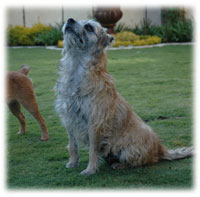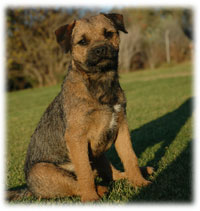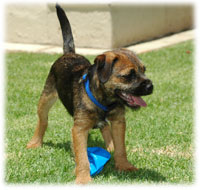| HISTORY:
|
The
Border Terrier was originally bred in the Cheviot Hills area near
the border between England and Scotland. Farmers bred this dog for
hunting foxes, otters, vermin and badger which preyed on their livestock,
in the 18th century. |
|
| DESCRIPTION:
|
The
Border Terrier is a medium sized spunky terrier with
a coarse, wire double coat.
The coat type of a Border Terrier has a lot of variations
across individual dogs, some develop longish, shaggy hair
and others never go on to develop a full coat and remain relatively
smooth in coat. The Border Terrier comes in red grizzle, blue &
tan, tan, grizzle & tan or less commonly wheaten. Small patches
of white are permissible on the chest.
Border Terrier coats are smooth up to about a year (see Merlin)
- then surely develops into a wire coat such as that of Baardjie.
Some breeders selectively pulls the wire hairs of their border terriers
for 'showing' purposes which gives them, once again, a 'smooth'
look like that of the younger dogs.
The Border Terrier has a “otter” shaped head with dark
lively eyes, a short muzzle, black nose and small ears, which fold
forward into a “V” shape. The tail is relatively short
and tapers from a thicker base to the tip.
Height: Dogs - 33-41cm. Bitches - 28 – 36cm.
Weight: Dogs – 6-7kg. Bitches – 5-6kg.
Their average life span is 12 – 14 years.
|
| TEMPERAMENT:
|
Border
Terriers are friendly, smart, energetic and playful.
They can make wonderful family pets as they are good with children
and thrives on human interaction and attention. They are big-hearted
and very affectionate little dogs that love their owners and if
they know that something pleases you, then that is what they will
do. The Border Terrier will alert you of strangers on your property
but are generally not aggressive. Border Terriers generally get
on well with other dogs.
However, if they dislike another dog, they do not hesitate to start
a fight and, as with most terriers, it can be difficult to stop
them. However, you should not trust this breed with a pet rabbit,
hamster, bird or other small creatures.
They will get along well with a family cat that is in the home,
but stray cats or your neighbor’s cat may soon learn that
your dog is not their friend. Border Terriers must be trained carefully
from the beginning to learn proper social behavior with other animals
and dogs, especially larger breeds.
|
   |
| TRAINING
& ABILITY: |
They will not respond to harsh or heavy-handed methods that break
their spirit and make training them more difficult.
Border Terriers are quick learners, but training must be done with
praise, motivation, reward, respect,
patience and consistency. Border Terriers must be trained carefully
from the beginning to learn proper social behavior with other animals
and dogs, especially larger breeds.
Today the Border Terriers are used for tracking, agility, competitive
obedience, showing and hunting.
|
| EXERCISE:
|
As
they were bred to hunt, they need plenty of exercise.
If you are taking your Border Terrier for a jog or walk in the park,
make sure it is on a leash, as they are notorious for chasing small
creatures and any moving object.
The breed will do well in an apartment dwelling provided they receive
sufficient physical exercise and mental stimulation.
|
| GROOMING:
|
The
durable, wiry coat needs brushing from time to time
and the coat should be stripped by hand (not clipped), as the top
coat becomes long and shaggy and eventually dies.
The Border Terrier sheds little to medium hair. Only bathe them
when necessary. |
|